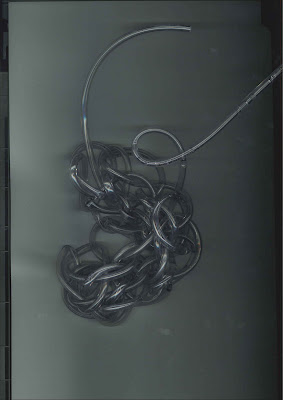Our proposal seeks an atmosphere of unpredictability and spontaneity.
We are working with the idea of Re-Casting an everyday material, which in our case is clear tubing. This material is a household object which tends to be hidden, but through exposing this material and turning it into a complex structure both the function and aesthetics of the material are emphasised. The knitted tubing forms a flexible yet strong structure – the material is able to be pulled and compressed but it will still retain its form. This process transforms the rigidity of the material into a flexible structure. The application of the simple process of knitting and layering on a large scale creates a complex system which is amplified by water being pumped through it.
We are retaining the intended function of the tubing by using it as a means for the transportation of a fluid. But it is made more complex by the water travelling through the knitted pattern. The bubbles trace the path of the tubes. Throughout the entire structure the tubes are connected to the difference sides of the structure so that for one side there is only one path for the water to take and when viewing this installation the water will make its way to the base from the top over the course of the night. The rate of flow of water is dependent on the movement and concentration of people around and inside the structure, and the pump will be triggered by movement of people, controlled via motion detecting sensors placed around the structure.
Initially, the audience is oblivious to their individual effects on the skyrise, as familiarity grows they become aware of the influence they exert and this process reveals to them the control they have over the appearance of the structure and an interactive connection is established. As the water moves through, the light from inside will be refracted creating an impulsive and ever-changing image. The reflective qualities of the tubing and the water will work with the lights to give the structure a weightless and serene aesthetic. This will mask the internal support elements of the knitted walls. Four steel poles are holding the entire structure together and the knitted tubing will provide further strength giving a self supporting appearance to our proposal.
From inside there will be a sensory experience for the audience. As the water moves through ad around the person standing inside the structure, they are fully enveloped by the movement and a rain like atmosphere spontaneously awakened by their unaware interactions with the design is made apparent. They will be able to hear the movement of water whilst viewing the map like image the bubbles and water create by their presence. The vibrations due to the flow of water, combined with the plastic and textured surface of the knitted arrangement will provide a highly interactive experience.
 |
| Working process |
 |
| Plan, section, detail & perspective |
We are still looking for the right tubing - the tubing we have been using currently becomes creased/crushed and blocks any water from travelling through. We need something flexible enough to knit with but strong enough to keep it's shape.





































